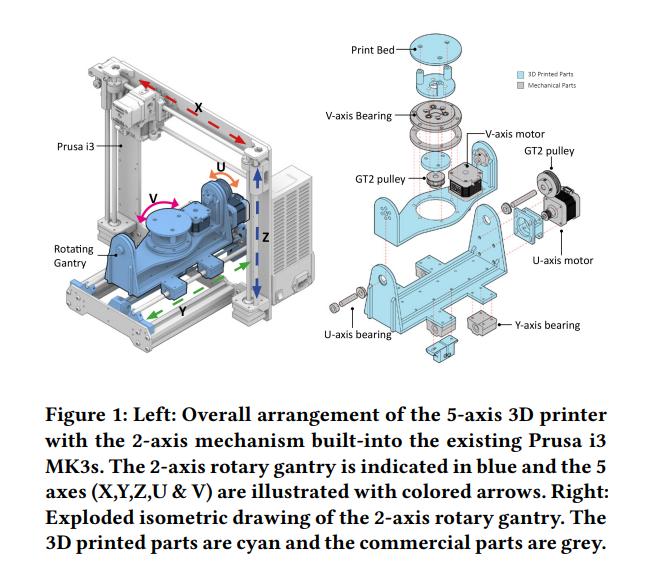
From its early conception in the world of science-fiction, the 3D printer is now well on its way to the mainstream. About 2.1 million 3D printers were sold in 2020, and that total is expected to reach 15.3 million units by 2028. A recent Statista report projects a robust compound annual growth rate of 17 percent in the global market for 3D printing products and services between 2020 and 2023. Along with its practical in-home use, 3D printing is also an essential technique for fabricating physical prototypes in a wide range of industries, due to the ease of constructing bespoke and complex geometries on demand.
While the typical 3D printer has a 3-axis configuration, 5-axis 3D printing offers performance advantages such as support-less printing, curved layer deposition, conformal (uneven) surface finishes and direct printing of functional materials on conformal surfaces. Such 5-axis benefits however remain out of reach for many users due to a lack of available software and the prohibitively large cost and size of the hardware.
To address these issues, a team from Imperial College London and Microsoft Research has proposed a cheap and accessible way to upgrade popular off-the-shelf 3-axis 3D printers to 5-axis 3D printers.
The conventional layer-by-layer deposition process of 3-axis fused filament fabrication (FFF) 3D printers makes them affordable and easy to use, but the resulting products can often exhibit unfavourable characteristics such as visible layers, rough surface finishes, uneven mechanical properties and the inclusion of sacrificial support material.

Various techniques have been proposed and developed to expand the capability of regular 3-axis 3D printing, with 5-axis 3D printing among the most promising. The team thus set out to lower the entry barrier of 5-axis 3D printing by transforming an open-source desktop 3D printer, the Prusa i3 MK3s, into a 5-axis machine by adding a 3D printed 2-axis rotating gantry. The researchers note that
The 2-axis gantry is built with a mixture of 3D-printed parts and readily-available mechanical parts such as belts and pulleys. The researchers replace the original Prusa i3 electronics board with Duet 2, a RepRap firmware compatible 3D printing board that allows up to 5 additional stepper motors. A conformal slicing tool is built on the visual scripting language Grasshopper to enable users to construct 3D files, produce the conformal toolpath, simulate the printing process and export the G-code all within a single digital environment. For 5-axis movement optimization, the team adopted speed optimization calculations from the literature on 5-axis CNC milling.
Because limited graphical user interface (GUI) support for conformal slicers creates an additional barrier for users, the team also developed a novel GUI that runs within the popular Rhino CAD package to enable users to generate the necessary conformal toolpaths with ease.
Overall, this work shows that 5-axis 3D conformal printing can be achieved with relatively simple and inexpensive modifications to 3-axis printers. The team believes this increased access to conformal printing can contribute to research areas such as printed electronics, meta-materials and lightweight lattice structures.
The paper Open5x: Accessible 5-Axis 3d Printing and Conformal Slicing is on arXiv.
Author: Hecate He | Editor: Michael Sarazen
We know you don’t want to miss any news or research breakthroughs. Subscribe to our popular newsletter Synced Global AI Weekly to get weekly AI updates.